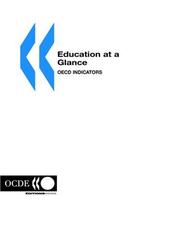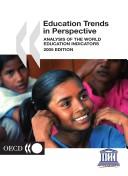| Listing 1 - 10 of 14 | << page >> |
Sort by
|

ISBN: 1280172088 9786610172085 9264102353 9264102337 Year: 2003 Publisher: Paris : OECD,
Abstract | Keywords | Export | Availability | Bookmark
 Loading...
Loading...Choose an application
- Reference Manager
- EndNote
- RefWorks (Direct export to RefWorks)
Across OECD countries, governments are seeking policies to make education more effective while searching for additional resources to meet the increasing demand for education. The 2003 edition of Education at a Glance: OECD Indicators enables countries to see themselves in the light of other countries' performance.
Book
ISBN: 3763948937 3763948929 Year: 2011 Publisher: Paris : OECD,
Abstract | Keywords | Export | Availability | Bookmark
 Loading...
Loading...Choose an application
- Reference Manager
- EndNote
- RefWorks (Direct export to RefWorks)
HauptbeschreibungWelche Bildungssysteme sind effizient? Was kann man von der Bildungspolitik anderer Länder lernen? Die aktuelle Ausgabe der Studie ermöglicht jedem Land, sein eigenes Bildungssystem im Verhältnis zu anderen Ländern zu betrachten: OECD-Indikatoren vergleichen die Bildungsniveaus und Bedingungen für Bildung der OECD-Länder untereinander. Sie erfassen, wer sich am Bildungswesen beteiligt, was dafür aufgewendet wird, wie Bildungssysteme operieren und welche Ergebnisse sie erzielen. Vom Vergleich von Schülerleistungen in Schlüsselfächern über den Zusammenhang zwische
Education -- Evaluation -- Statistics -- Cross-cultural studies. --- Education -- OECD countries -- Statistics -- Periodicals. --- Educational indicators -- Cross-cultural studies -- Statistics. --- Education --- Social Sciences --- Education, Special Topics --- Organisation for Economic Co-operation and Development. --- OECD --- Organisation for Economic Co-operation and Development --- OESO --- OCDE

ISBN: 1280083484 9786610083480 9264193227 9264186999 Year: 2001 Publisher: Paris Organization for Economic Cooperation and Development
Abstract | Keywords | Export | Availability | Bookmark
 Loading...
Loading...Choose an application
- Reference Manager
- EndNote
- RefWorks (Direct export to RefWorks)
This report surveys teaching and learning conditions in 18 mainly developing countries - Argentina, Brazil, Chile, China, Egypt, India, Indonesia, Jordan, Malaysia, Paraguay, Peru, the Philippines, Uruguay, the Russian Federation, Sri Lanka, Thailand, Tunisia and Zimbabwe - and provides corresponding data for developed countries in the OECD area.  It highlights a number of disparities in such areas as teacher training and remuneration, and makes some recommendations as to how these can be addressed.
Education -- OECD countries -- Statistics. --- Education -- Statistics. --- Educational evaluation -- OECD countries -- Statistics. --- Educational evaluation -- Statistics. --- Educational indicators -- OECD countries. --- Educational indicators. --- Education --- Educational indicators --- Education and state --- Economic aspects --- Educational accountability --- Children --- Education, Primitive --- Education of children --- Human resource development --- Instruction --- Pedagogy --- Schooling --- Students --- Youth --- Civilization --- Learning and scholarship --- Mental discipline --- Schools --- Teaching --- Training

ISBN: 1280357398 9786610357390 926401361X 9264013601 Year: 2005 Publisher: Montreal : Paris : Unesco Institute for Statistics ; Organisation for Economic Co-Operation and Development,
Abstract | Keywords | Export | Availability | Bookmark
 Loading...
Loading...Choose an application
- Reference Manager
- EndNote
- RefWorks (Direct export to RefWorks)
This publication provides a range of comparable, cross-national education indicators for 19 middle-income non-OECD countries comprising over 50 per cent of the world population. In particular, it examines the extent to which countries were able to widen participation in higher levels of education between 1995 and 2002/3. Coverage includes data on educational attainment, education expectancy, enrolment rates of different age groups, age ranges of universal primary and secondary education, female participation, upper secondary enrolment patterns, entry rates into upper secondary and tertiary ed
Education -- Economic aspects. --- Education -- OECD countries -- Statistics. --- Educational indicators. --- Education --- Social Sciences --- Theory & Practice of Education --- Children --- Education, Primitive --- Education of children --- Human resource development --- Instruction --- Pedagogy --- Schooling --- Students --- Youth --- Civilization --- Learning and scholarship --- Mental discipline --- Schools --- Teaching --- Training --- Educational evaluation --- Educational indicators --- Evaluation en éducation --- Indicateurs éducationnels --- Statistics. --- Statistiques
Book
ISBN: 1283291169 9786613291165 9264117059 9264114203 Year: 2011 Publisher: [Paris] : OECD,
Abstract | Keywords | Export | Availability | Bookmark
 Loading...
Loading...Choose an application
- Reference Manager
- EndNote
- RefWorks (Direct export to RefWorks)
Across OECD countries, governments are having to work with shrinking public budgets while designing policies to make education more effective and responsive to growing demand. The 2011 edition of Education at a Glance: OECD Indicators enables countries to see themselves in the light of other countries' performance. It provides a broad array of comparable indicators on education systems and represents the consensus of professional thinking on how to measure the current state of education internationally. The indicators show who participates in education, how much is spent on it, and how educati
Education -- Evaluation -- Statistics -- Periodicals. --- Education -- OECD countries -- Statistics -- Periodicals. --- Educational indicators -- Cross-cultural studies -- Statistics -- Periodicals. --- Education --- Social Sciences --- Theory & Practice of Education --- Educational indicators --- Cross-cultural studies --- Evaluation --- Children --- Education, Primitive --- Education of children --- Human resource development --- Instruction --- Pedagogy --- Schooling --- Students --- Youth --- Civilization --- Learning and scholarship --- Mental discipline --- Schools --- Teaching --- Training --- Educational accountability
Book
ISBN: 9264046852 9264046801 9264946802 Year: 2008 Publisher: Paris : OCDE,
Abstract | Keywords | Export | Availability | Bookmark
 Loading...
Loading...Choose an application
- Reference Manager
- EndNote
- RefWorks (Direct export to RefWorks)
Education -- Evaluation -- Statistics -- Cross-cultural studies. --- Education -- OECD countries -- Statistics. --- Educational indicators -- Cross-cultural studies -- Statistics. --- Electronic books. -- local. --- Education --- Social Sciences --- Theory & Practice of Education --- Educational indicators --- Cross-cultural studies --- Evaluation --- Statistics --- Children --- Education, Primitive --- Education of children --- Human resource development --- Instruction --- Pedagogy --- Schooling --- Students --- Youth --- Educational accountability --- Civilization --- Learning and scholarship --- Mental discipline --- Schools --- Teaching --- Training
Book
ISBN: 1282304534 9786612304538 926402476X 9264024751 Year: 2009 Publisher: Paris : OECD,
Abstract | Keywords | Export | Availability | Bookmark
 Loading...
Loading...Choose an application
- Reference Manager
- EndNote
- RefWorks (Direct export to RefWorks)
The 2009 edition of Education at a Glance: OECD Indicators enables countries to see themselves in the light of other countries' performance. It provides a rich, comparable and up-to-date array of indicators on the performance of education systems and represents the consensus of professional thinking on how to measure the current state of education internationally. The indicators look at who participates in education, what is spent on it and how education systems operate and at the results achieved. The latter includes indicators on a wide range of outcomes, from comparisons of students' perfor
Education -- Evaluation -- Statistics -- Cross-cultural studies -- Periodicals. --- Education -- OECD countries -- Statistics -- Periodicals. --- Educational indicators -- Cross-cultural studies -- Statistics -- Periodicals. --- Educational indicators --- Education --- Cross-cultural studies --- Evaluation --- Children --- Education, Primitive --- Education of children --- Human resource development --- Instruction --- Pedagogy --- Schooling --- Students --- Youth --- Civilization --- Learning and scholarship --- Mental discipline --- Schools --- Teaching --- Training --- Educational accountability
Book
ISBN: 9264045643 9264040986 Year: 2009 Publisher: Paris : OCDE,
Abstract | Keywords | Export | Availability | Bookmark
 Loading...
Loading...Choose an application
- Reference Manager
- EndNote
- RefWorks (Direct export to RefWorks)
Education -- Evaluation -- Statistics -- Cross-cultural studies. --- Education -- OECD countries -- Statistics. --- Educational indicators -- Cross-cultural studies -- Statistics. --- Electronic books. -- local. --- Theory & Practice of Education --- Education --- Social Sciences --- Educational indicators --- Cross-cultural studies --- Evaluation --- Statistics --- Children --- Education, Primitive --- Education of children --- Human resource development --- Instruction --- Pedagogy --- Schooling --- Students --- Youth --- Civilization --- Learning and scholarship --- Mental discipline --- Schools --- Teaching --- Training --- Educational accountability
Book
ISBN: 9264068430 9264068414 9264068155 Year: 2009 Publisher: Paris : OCDE,
Abstract | Keywords | Export | Availability | Bookmark
 Loading...
Loading...Choose an application
- Reference Manager
- EndNote
- RefWorks (Direct export to RefWorks)
Education -- Evaluation -- Statistics -- Cross-cultural studies. --- Education -- OECD countries -- Statistics. --- Educational indicators -- Cross-cultural studies -- Statistics. --- Electronic books. -- local. --- Theory & Practice of Education --- Education --- Social Sciences --- Educational indicators --- Cross-cultural studies --- Evaluation --- Statistics --- Children --- Education, Primitive --- Education of children --- Human resource development --- Instruction --- Pedagogy --- Schooling --- Students --- Youth --- Civilization --- Learning and scholarship --- Mental discipline --- Schools --- Teaching --- Training --- Educational accountability
Book
ISBN: 1282797395 9786612797392 9264075666 9264055983 Year: 2010 Publisher: Paris, France : OECD Pub.,
Abstract | Keywords | Export | Availability | Bookmark
 Loading...
Loading...Choose an application
- Reference Manager
- EndNote
- RefWorks (Direct export to RefWorks)
Across OECD countries, governments are seeking policies to make education more effective while searching for additional resources to meet the increasing demand for education. The 2010 edition of Education at a Glance: OECD Indicators enables countries to see themselves in the light of other countries' performance. It provides a rich, comparable and up-to-date array of indicators on systems and represents the consensus of professional thinking on how to measure the current state of education internationally. The indicators show who participates in education, how much is spent on it and how educ
Education -- Evaluation -- Statistics -- Cross-cultural studies -- Periodicals. --- Education -- OECD countries -- Statistics -- Periodicals. --- Educational indicators -- Cross-cultural studies -- Statistics -- Periodicals. --- Education --- Children --- Education, Primitive --- Education of children --- Human resource development --- Instruction --- Pedagogy --- Schooling --- Students --- Youth --- Civilization --- Learning and scholarship --- Mental discipline --- Schools --- Teaching --- Training
| Listing 1 - 10 of 14 | << page >> |
Sort by
|

 Search
Search Feedback
Feedback About UniCat
About UniCat  Help
Help News
News